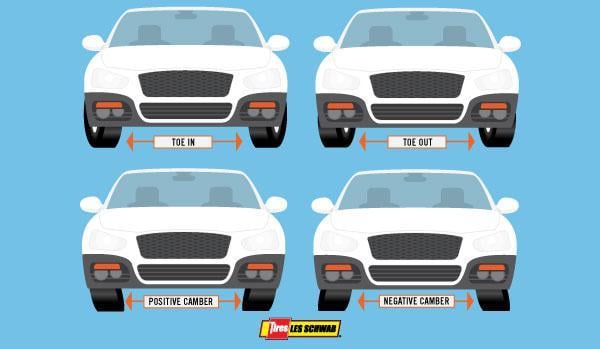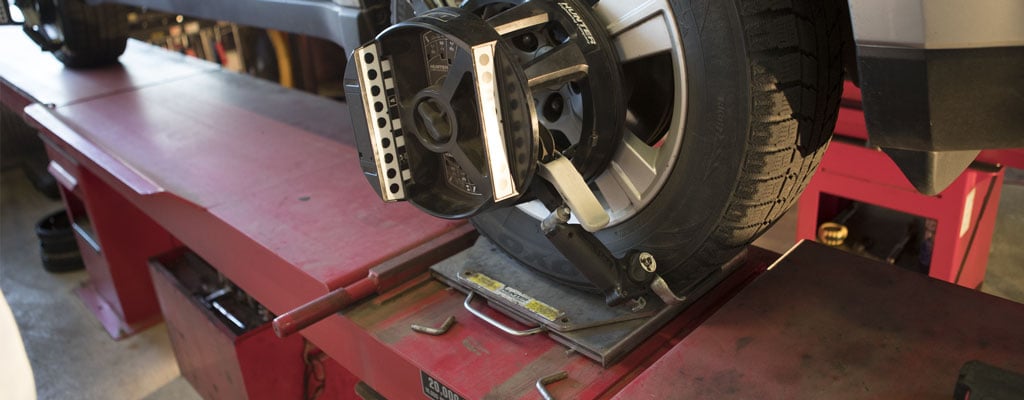Wheel Alignment FAQ
What Is a Wheel Alignment?
Though it’s sometimes subtle, the alignment of your wheels can get out of whack from everyday driving. This reduces your vehicle’s drivability, lowers gas mileage and causes early tire wear. An alignment is the process of adjusting the angles of your vehicle’s wheels back within original specifications to improve their contact with the road.
Are Wheel Alignments Necessary?
An alignment improves vehicle safety by keeping the right amount of the tire in contact with the road and preventing your vehicle from pulling to the left or right. A properly aligned vehicle has a smoother ride and optimal gas mileage. Keeping the wheels aligned also extends tire life.
What Affects Wheel Alignment?
Over time, normal settling of the suspension, including fatigue of springs and bushings (rubber cushions that dampen the amount of movement and noise), will gradually change alignment. Hitting a pothole, going over big bumps, rubbing up against a curb or rolling over debris can also push wheels out of alignment. Additionally, aggressive driving, carrying heavy loads, bent or worn suspension/steering parts, or a slight fender-bender can trigger misalignment. To improve your vehicle safety, get your vehicle aligned twice a year or when you buy new tires. Other times to get your alignment checked include:
-
After a sharp impact with a curb or pothole
-
If you go offroading a lot
-
When tires are wearing unevenly
-
Anytime you lower or lift your vehicle
-
When steering or suspension parts that affect the tire angles are replaced
-
If you notice your vehicle drifts or pulls to one side
-
If the steering wheel is off-center when you’re pointing straight
-
After an accident
How Can I Tell If My Vehicle is Misaligned?
Even if your vehicle is out of alignment, you might not notice it over time. Indications of a misaligned vehicle include:
![]()
Uneven
Tire Wear
![]()
Steering Wheel
Off-Center
![]()
Pulling or Drifting
When Steering
Can Misalignment Cause Steering Wheel Vibration?
Not likely. Vibrations in the steering wheel, the floorboard or the seat (especially at highway or freeway speeds) is likely a sign that one or more of your tire/wheel assemblies is out-of-balance, or you are experiencing another tire issue.
Can Misalignment Cause Noise?
No. Generally, any noise from misalignment is caused by abnormal tire wear. If tires are the source of road noise, an alignment correction may be needed. However, this won’t solve the noise problem.
Will Misalignment Affect My Tires?
Yes. If they show moderate-to-severe edge wear or feathered wear, it likely means they’re out of alignment. This is often an indicator that the toe or the camber angle is off.

Camber Affects Wear and Cornering: The inward and outward tilt of the tire and wheel assembly (viewed from the front of the vehicle) is called camber. When the top of the tire is leaning inward, it is a negative camber. Positive camber has the top of the tire tilting outward. Each manufacturer sets a specific camber alignment for every vehicle it produces, which might be either positive, negative or zero (0º). When the camber is at the correct angle, the tire and wheel will roll straight.
Generally, camber plays a key-role in cornering performance. If the camber is out of the manufacturer’s range, it can cause handling issues and excessive tire wear, which costs you money. If a vehicle has rear-camber adjustments, adjusting the rear camber plays a big role in straight-line stability and cornering.
Toe Is the Most Important Angle for Tire Life: Of all the angles, the toe can fall out of alignment the easiest. A toe that is properly calibrated to manufacturer specifications (which can be either slightly positive or negative) will be at zero (0º) when on the road. This means all of the tire and wheel assemblies (front and rear) are pointing in the same direction. When the toe is at the correct angle, there’s less friction on the tires as they roll. When they are facing away from each other (toe-out) or toward each other (toe-in), they’re essentially scrubbing on the road ever so slightly with every passing mile. This can reduce tire life.
How Are Wheel Alignments Done?
A wheel alignment is done using an alignment machine that measures your wheel angles. These are calculated and compared against your vehicle’s original specifications.
-
The technician makes adjustments to the camber, caster, and toe of each wheel as needed.
-
A real-time computer readout shows when the target angles are met.
-
Your steering wheel is checked to ensure it is centered.
-
Finally, your vehicle is given a quick test drive.
What Are the Types of Alignment?
Your technician will advise what kind of alignment is best for your vehicle type. Generally, a four-wheel alignment will cost more than a standard or thrust alignment.
Thrust Alignment: A thrust alignment is the most accurate alignment for vehicles without adjustable rear suspension. Only the front wheels are adjusted. Here’s how: There’s no guarantee both rear wheels are pointed straight ahead as they should be. One may be pointed exactly forward and the other slightly off. Or both their angles could be off. Since this can’t be adjusted, the front wheels are aligned as closely as possible to the thrust line, which is the average of where the two rear wheels point. This compensates enough to get a centered steering wheel.
Four-Wheel Alignment: This is done on vehicles with adjustable rear suspension, to bring all four wheels of your vehicle back into your vehicle’s original specifications. All four wheels are aligned to the center of the vehicle. First, the rear axle angles are measured and adjusted, then the front. This is the best, most accurate, manufacturer-recommended alignment for vehicles with adjustable rear suspension.
Should I Get an Alignment When I Get New Tires?
Yes. Getting an alignment when you replace tires is one of the best ways to get the most mileage out of them. Be sure to ask for an alignment, since it’s not generally part of the tire purchase price.
How Often Is Wheel Alignment Needed?
Regular alignments are part of basic auto maintenance. Catching misalignment early means you can correct your wheel’s positions before you have premature tire wear. Cars usually go out of alignment gradually, so it’s important to check it at least annually, or twice a year if you travel roads that are washboard, rutted or full of potholes.
What Other Times Should Alignment Be Checked?
-
After a sharp impact with a curb or pothole
-
If you go offroading a lot
-
When tires are wearing unevenly
-
Anytime you lower or lift your vehicle
-
When steering or suspension parts that affect the tire angles are replaced
-
If you notice your vehicle drifts or pulls to one side
-
If the steering wheel is off-center when you’re pointing straight
-
After an accident
Les Schwab does free visual alignment inspections. If we recommend an alignment but find during the course of the work that your alignment is good and can’t be improved, there’s no charge.)
Is Four-Wheel Alignment Only for 4-Wheel-Drive Vehicles?
Regardless of whether they’re 4WD, front-wheel-drive or rear-wheel-drive, most cars and many SUVs today are four-wheel alignable. These vehicles should get a four-wheel alignment because the rear is just as likely to be out of alignment and cause uneven tire wear as the front.
Does Misalignment Affect Gas Mileage?
Yes. When your wheels are properly aligned, there’s less rolling resistance. Tires with less rolling resistance experience less friction which may improve fuel efficiency. If the situation continues, the tires will wear unevenly and lead to worse gas mileage.
Is Alignment the Same As Balancing?
No. Alignment and balancing are two very different repairs. Rebalancing tires is a process of attaching small weights, just fractions of ounces, to the wheel. This ensures the weight of the wheel is even around the entire unit. Although they’re round, tires have manufacturing imperfections and wear that create lighter and heavier areas. The weights compensate for this.
Rebalancing is done in a tire shop by putting the wheel-tire unit on a tire-balancing machine that detects imbalance in the tire/wheel assembly. This shows where the imbalance is and the amount of weight needed to counter that imbalance. It’s most often done when new tires are installed. Les Schwab performs tire balancing with every rotation. However, it is not part of an alignment.
What’s Included With an Alignment?
Les Schwab wheel alignments include a tire inspection, test drive before, steering and suspension inspection, tire pressure check and adjustment, alignment angles measured and adjusted, test drive after, and a printed report showing before and after measurements. Alignments done at Les Schwab Tires are covered by a 30-day guarantee, which includes labor.
Will an Alignment Fix a Crooked Steering Wheel? Loose Steering?
An off-center steering wheel is one sign of misalignment. A wheel alignment may restore the steering wheel to a centered position if there aren’t other undiagnosed problems.
When alignment angles are out of the vehicle’s original specifications, steering can feel slightly loose. This condition can be corrected by a wheel alignment. But if you’re noticing a lot more steering wheel movement than normal, there may be worn steering or suspension parts. In this case, the loose parts should be identified in the pre-alignment inspection and repairs should be recommended before aligning.
Are Wheel Alignments Covered Under Warranty?
Check your vehicle’s owner manual for the original warranty.
How Much Does a Wheel Alignment Cost?
It varies according to vehicle type, shop, region and type of alignment. A quality shop will advise in advance what type is best and what it will cost before performing the work. A great shop only charges for work that is actually needed once the job is underway.
Where Can I Get a Wheel Alignment Done?
Les Schwab Tires offers full wheel alignment services — including adjustments and free inspections — usually without an appointment.
How Long Does a Wheel Alignment Take?
A wheel alignment service, once your vehicle is in our service bay, can take up to one hour. The time frame depends on the severity of the misalignment and whether or not your vehicle requires a thrust, or four-wheel alignment. The pros at your local Les Schwab Tires can give you an accurate time estimate.
Find A Store